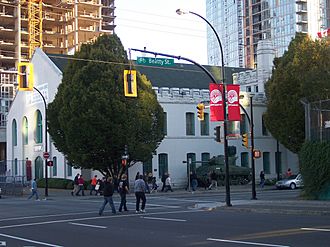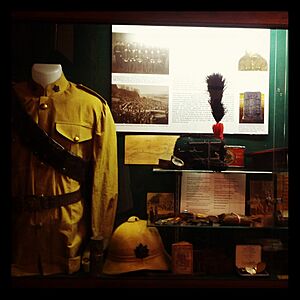Beatty Street Drill Hall facts for kids
Quick facts for kids Beatty Street Drill Hall |
|
|---|---|

Beatty Street Drill Hall
|
|
| General information | |
| Type | Drill Hall / armoury |
| Address | 620 Beatty Street Vancouver, British Columbia V6B 2L9 |
| Current tenants | The British Columbia Regiment (Duke of Connaught's Own) |
| Inaugurated | 30 September 1901 |
| Owner | Canadian Forces |
| Design and construction | |
| Architect | T.W. Fuller |
| Designations | Recognized Federal Heritage Building |
The Beatty Street Drill Hall is a special building in Vancouver, British Columbia. It is used by the Canadian Forces as an armoury, which is like a training center and storage place for military equipment. It's the home base for a group called The British Columbia Regiment (Duke of Connaught's Own). This group is a special part of Canada's military reserves, focusing on scouting and gathering information. They are the oldest military group in Vancouver and the most important volunteer military group in British Columbia.
Building Design and Features
The Beatty Street Drill Hall was designed by an architect named T.W. Fuller. It officially opened on September 30, 1901. A very important person, the Duke of Cornwall (who later became King George V), was there for the opening.
This building looks a bit like a castle! It has two big, castle-like towers called turrets with special tops called battlements. Battlements are the notched walls you often see on old castles. Outside the building, there are also two tanks and a large 64-pounder gun. These features make the Beatty Street Drill Hall a well-known landmark in Vancouver. It is even listed as a very important heritage building.
The walls of the drill hall are very thick, about three and a half feet! The building sits on huge blocks of granite. The decorative stone around the top, called the parapet, is made from limestone that came from Gabriola Island. It also has a special rough-looking stone trim.
Inside, the Drill Hall has a large open space called a parade square, where soldiers can practice. There are also offices and storage rooms. In the past, it even had a firing range and a bowling alley! The area across the street, which is now a parking lot called Cambie Street Grounds, was once used for training too.
Important Memorials
The Drill Hall is home to several memorials that honor brave soldiers.
- A stone monument remembers local soldiers who died in the First and Second World Wars. It also honors veterans of the Korean War and those who served in peacekeeping missions.
- In 1970, Dutch Canadians in Vancouver gave a copper plaque. It thanks the B.C. Regiment for helping to free Holland during the 1944-1945 campaign.
- A wooden Celtic cross remembers the officers and soldiers who bravely fought and died at Vimy Ridge.
- Another plaque was put up by fellow officers and soldiers. It honors the men of the 28th Canadian Armoured Regiment who died during the Second World War.
- A plaque remembers members of the 6th Regiment Duke of Connaught's Own Rifles. They lost their lives in the South African War, which happened from 1899 to 1902.
- There is also a plaque dedicated to Lt. Colonel George McSpadden and the heroes of the 11th Regiment Irish Fusiliers of Canada.
- On October 17, 1994, a plaque was dedicated to celebrate the special connection between the naval ship HMCS Vancouver (FFH 331) and the B.C. Regiment.
Regimental Museum
The Regimental Museum of the BC Regiment is located right inside the Beatty Street Drill Hall in Metro Vancouver. This museum is a great place to learn about military history! It has displays that go all the way back to 1883. You can see old uniforms, weapons, medals, and a large collection of photographs. These items tell the story of The British Columbia Regiment (Duke of Connaught's Own) and the Beatty Street Drill Hall itself.
The museum was started in 1982 and is open to the public on Wednesdays. Besides the BC Regiment, a youth group called the 2290 British Columbia Regiment (Duke of Connaught's Own) Cadet Corps also meets and trains at the armoury.
More to Explore



